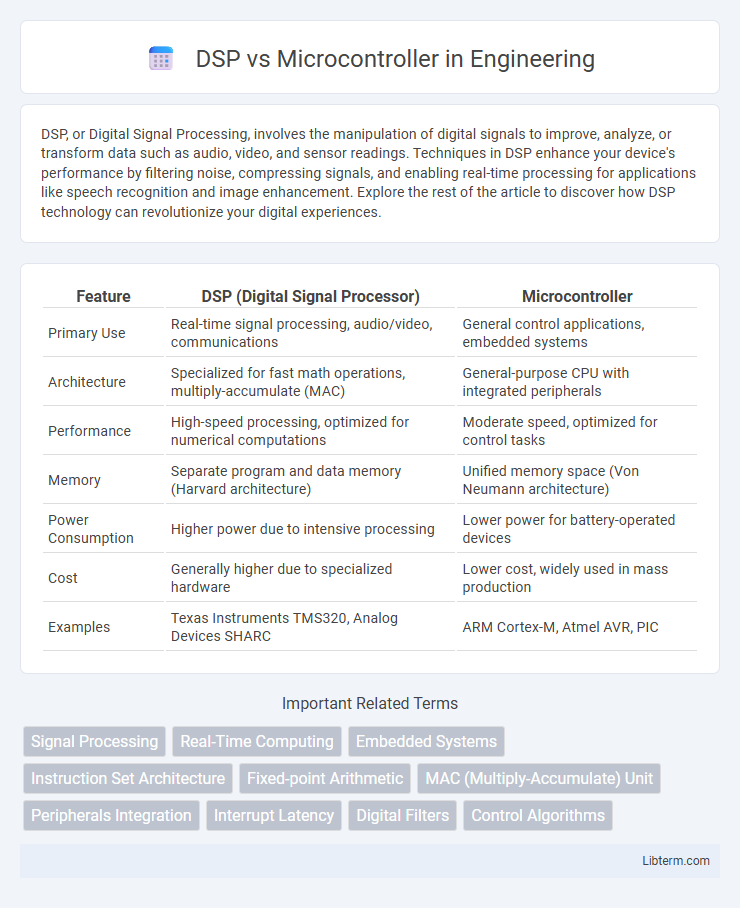DSP, or Digital Signal Processing, involves the manipulation of digital signals to improve, analyze, or transform data such as audio, video, and sensor readings. Techniques in DSP enhance your device's performance by filtering noise, compressing signals, and enabling real-time processing for applications like speech recognition and image enhancement. Explore the rest of the article to discover how DSP technology can revolutionize your digital experiences.
Table of Comparison
| Feature | DSP (Digital Signal Processor) | Microcontroller |
|---|---|---|
| Primary Use | Real-time signal processing, audio/video, communications | General control applications, embedded systems |
| Architecture | Specialized for fast math operations, multiply-accumulate (MAC) | General-purpose CPU with integrated peripherals |
| Performance | High-speed processing, optimized for numerical computations | Moderate speed, optimized for control tasks |
| Memory | Separate program and data memory (Harvard architecture) | Unified memory space (Von Neumann architecture) |
| Power Consumption | Higher power due to intensive processing | Lower power for battery-operated devices |
| Cost | Generally higher due to specialized hardware | Lower cost, widely used in mass production |
| Examples | Texas Instruments TMS320, Analog Devices SHARC | ARM Cortex-M, Atmel AVR, PIC |
Introduction to DSP and Microcontroller
Digital Signal Processors (DSPs) are specialized microprocessors designed for high-speed numerical calculations, particularly in real-time signal processing applications such as audio, video, and communications. Microcontrollers are integrated circuits containing a CPU, memory, and peripherals, optimized for control-oriented applications in embedded systems like automotive, home appliances, and industrial automation. While DSPs excel in executing complex mathematical algorithms efficiently, microcontrollers provide versatile general-purpose control with lower power consumption and broader interfacing capabilities.
Core Architecture Differences
DSPs feature specialized Harvard architecture with separate memory spaces for instructions and data, enabling high-speed numerical processing and parallelism critical for real-time signal processing tasks. Microcontrollers typically use a Von Neumann or modified Harvard architecture that integrates program and data memory, optimizing for general-purpose control applications with simpler, versatile processing capabilities. DSP cores include specialized arithmetic units such as MAC (multiply-accumulate) units for efficient mathematical operations, whereas microcontrollers rely on general-purpose ALUs suited for control logic and peripheral management.
Key Functionalities and Applications
Digital Signal Processors (DSPs) specialize in high-speed mathematical computations for real-time signal processing tasks, excelling in applications like audio, video, and telecommunications where rapid data manipulation is crucial. Microcontrollers integrate CPU, memory, and peripherals on a single chip, designed for control-oriented tasks in embedded systems such as automotive controls, home appliances, and IoT devices. DSPs optimize algorithms for filtering, FFT, and modulation, while microcontrollers manage I/O interfaces, control logic, and low-power operations in diverse embedded applications.
Performance and Speed Comparison
Digital Signal Processors (DSPs) deliver superior performance and speed for real-time signal processing tasks due to their specialized architecture with multiple MAC (Multiply-Accumulate) units and optimized instruction pipelines. Microcontrollers typically operate at lower clock speeds and lack dedicated hardware for parallel operations, resulting in slower processing for math-intensive applications. DSPs are ideal for applications requiring high throughput and low latency, such as audio and video processing, whereas microcontrollers excel in control-oriented tasks with less computational demand.
Power Consumption Analysis
Digital Signal Processors (DSPs) typically consume more power than microcontrollers due to their high-speed arithmetic units and specialized hardware designed for intensive signal processing tasks. Microcontrollers, optimized for low-power operations, benefit from simpler architectures and sleep modes that significantly reduce energy usage during idle periods. Power consumption analysis reveals that selecting a device depends on workload intensity; DSPs excel in high-performance applications at the cost of higher power, whereas microcontrollers offer energy-efficient solutions for less demanding tasks.
Cost Implications and Budget Considerations
Digital Signal Processors (DSPs) generally incur higher initial costs due to their specialized architecture designed for high-speed numeric processing, making them ideal for complex signal analysis but potentially over budget for simple control tasks. Microcontrollers offer a cost-effective solution with integrated peripherals and lower unit prices, suited for applications with modest processing requirements and tight budget constraints. Choosing between DSP and microcontroller hinges on balancing the need for processing power against project budget, considering factors like development time, component price, and scalability.
Programming and Development Tools
DSPs (Digital Signal Processors) typically require specialized programming environments like Code Composer Studio or TI's DSP/BIOS, optimized for real-time signal processing and low-latency execution. Microcontrollers are often programmed with more general-purpose IDEs such as MPLAB, Atmel Studio, or Arduino IDE, which support a wide range of applications and provide extensive libraries and beginner-friendly debugging tools. The choice between DSP and microcontroller development tools depends heavily on the application's complexity, real-time processing needs, and available peripheral integration.
Scalability and Flexibility
DSPs offer high scalability in processing power with specialized architectures optimized for signal processing tasks, enabling efficient handling of complex algorithms across various performance levels. Microcontrollers provide greater flexibility by integrating diverse peripherals and supporting multiple communication protocols, making them ideal for versatile embedded system applications. Choosing between DSP and microcontroller depends on the need for scalable computational throughput versus adaptable multifunctional system design.
Real-World Use Cases
DSPs excel in real-time audio processing, telecommunications, and automotive radar systems due to their efficient handling of complex mathematical computations and signal filtering. Microcontrollers dominate in embedded systems like home automation, industrial controls, and consumer electronics, where versatility and low power consumption are critical. Industrial robotics leverage both DSPs for precise sensor data analysis and microcontrollers for overall system control and user interface management.
Choosing the Right Solution
Choosing between a DSP (Digital Signal Processor) and a microcontroller depends on the specific application requirements; DSPs excel in high-speed signal processing tasks like audio, video, and communication systems due to their optimized architecture for mathematical computations. Microcontrollers provide versatility and ease of integration for control-oriented applications, sensor interfacing, and general-purpose embedded systems, offering lower power consumption and cost-effectiveness. Evaluating processing power, real-time capabilities, development ecosystem, and application complexity is crucial for selecting the optimal solution.
DSP Infographic

 libterm.com
libterm.com